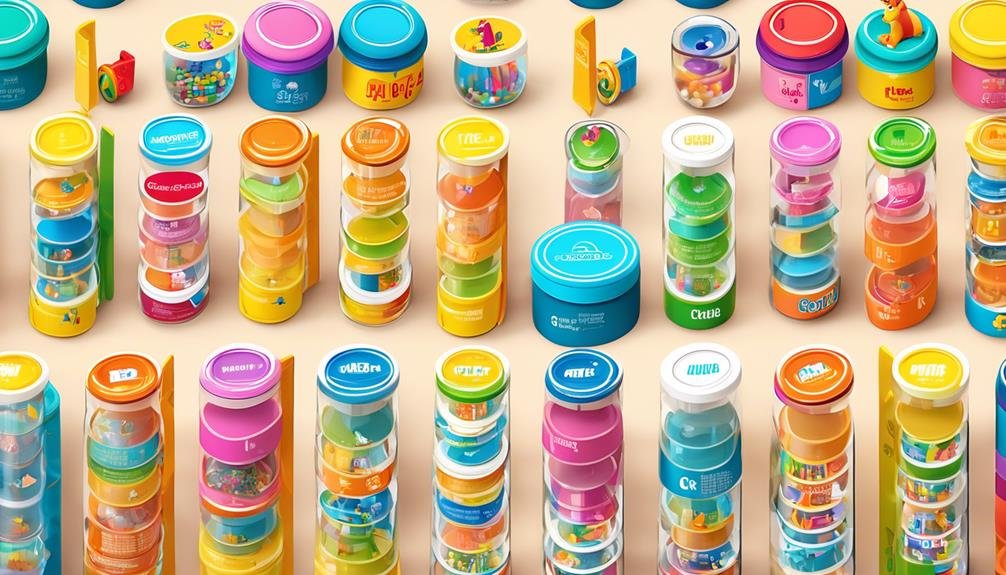Are you feeling like a captain navigating through a sea of toys in your children's play area? It's time to take charge and declutter that chaotic space! But where do you begin?
In this discussion, we will explore practical strategies to help you regain control over the toy invasion. From assessing the toy collection to creating a functional play area, we will guide you through the process step by step.
So, grab your organizing hat and get ready to transform your children's toy areas into serene havens of play and imagination.
Key Takeaways
- Gather and assess all toys, considering their condition and relevance to the child's interests and developmental stage.
- Repair or discard broken toys, and consider donating outgrown toys to charity or passing them along.
- Group similar toys together and use clear storage containers with labels for easy identification and organization.
- Implement a rotating toy system, where a set number of toys from each category are accessible at a time, to keep the play area clutter-free.
Assessing the Toy Collection
To effectively organize your children's toy area, it's essential to assess the toy collection. Take the time to go through each toy, evaluating its condition and relevance to your child's current interests and developmental stage.
Start by gathering all the toys in one place, so you can see the full extent of your collection. As you go through each toy, ask yourself a few key questions. Is the toy broken or missing pieces? If so, consider whether it can be repaired or if it's time to let go.
Is the toy age-appropriate? Some toys may have been outgrown or are no longer suitable for your child's age group. Consider donating these to a local charity or passing them along to friends or family.
Finally, think about whether the toy gets played with regularly. If it has been neglected for a long time, it may be time to make room for new toys that will spark your child's interest.
Sorting and Categorizing Toys
Now that you have assessed your toy collection, it's time to sort and categorize the toys to create a more organized and easily accessible toy area for your children. Sorting and categorizing toys not only helps you keep track of what you have, but it also makes it easier for your children to find and play with their toys.
Start by grouping similar toys together. This could include categories such as dolls, action figures, building blocks, puzzles, and art supplies. Once you have sorted the toys into categories, you can then decide on the best way to store them. Consider using bins, baskets, or shelves to keep each category of toys separate.
You may also want to consider labeling each storage container to make it even easier for your children to find and put away their toys. Simple labels with words or pictures can work well, especially for younger children who may not be able to read yet.
Remember to involve your children in the sorting and categorizing process. This can help them develop organizational skills and a sense of ownership over their toys. Encourage them to participate in the decision-making process and let them have a say in how their toys are organized.
Setting Up Clear Storage Solutions

Consider using clear storage containers to store and organize your children's toys. Clear containers have the advantage of allowing you to easily see what toys are inside without having to open each one, saving you time and effort. They also make it easier for your children to find and access their toys, promoting independent play and reducing frustration.
When selecting clear storage containers, opt for durable and stackable options that can withstand rough handling and maximize storage space. Look for containers with secure lids to prevent toys from spilling out and getting lost. Additionally, consider using smaller clear containers within larger ones to further categorize and separate toys by type or theme.
Label each container with descriptive and colorful labels to make it even easier for your children to identify and return toys to their proper place. By using clear storage solutions, you can create a visually appealing and organized toy area that's both functional and efficient.
Implementing Rotating Toy System
One effective way to keep your children's toys organized is by implementing a rotating toy system. This system involves periodically rotating the toys that are accessible to your children. By doing so, you can prevent toy overload and keep their play area clutter-free.
To implement a rotating toy system, start by dividing your children's toys into different categories, such as puzzles, building blocks, and stuffed animals. Then, create separate bins or boxes for each category.
Next, select a set number of toys from each category to be available to your children at any given time. Store the remaining toys in a designated storage area, such as a closet or basement. After a certain period of time, such as a week or a month, swap out the toys that are currently being used with the ones in storage.
This way, your children will always have a fresh selection of toys to play with, while the rest stay neatly organized. To make the process even smoother, consider labeling the bins or boxes with the categories and using clear containers for easy identification.
Additionally, involve your children in the process by letting them help choose which toys to rotate and encouraging them to put away the toys they're finished playing with.
Creating a Functional Play Area

To create a functional play area for your children, start by decluttering and organizing the space.
Begin by removing any broken or unused toys. Sort through the remaining toys and group them into categories, such as building blocks, stuffed animals, and art supplies. Use storage bins or baskets to keep each category separate and easily accessible. Consider labeling the bins to help your children learn to clean up after playtime.
Utilize shelves or cubbies to display and store larger items, like board games or puzzles. Make sure to leave space for your children to move around and play freely. Consider the layout of the room and arrange furniture in a way that maximizes play space.
Create designated play zones, such as a reading corner or a building area, to encourage different types of play. Keep the play area well-lit and comfortable with appropriate seating and cushions.
Lastly, regularly review and rotate toys to keep the play area fresh and exciting. By following these steps, you can create a functional and organized play area that will encourage your children's imagination and playtime.
Teaching Children to Clean Up
Once the play area is organized and functional, it's important to teach your children how to clean up after themselves. By instilling this habit early on, you aren't only teaching them responsibility but also helping them develop important life skills. Here are some tips to help you teach your children how to clean up:
- Set clear expectations: Clearly communicate your expectations regarding cleaning up their toys. Make it a part of their daily routine and emphasize the importance of keeping their play area tidy.
- Make it fun: Turn cleaning up into a game or a challenge. Use a timer and see how quickly they can clean up their toys. Offer small rewards or incentives to encourage them to complete the task.
- Lead by example: Show your children that cleaning up is something you do too. When they see you tidying up after yourself, they're more likely to follow your lead.
Frequently Asked Questions
How Can I Involve My Child in the Process of Decluttering and Organizing Their Toy Area?
You can involve your child in decluttering and organizing their toy area by making it a fun activity. Start by explaining the importance of keeping things tidy and let them choose which toys to keep or donate.
What Are Some Practical and Creative Ways to Store Toys in Small Spaces?
You can store toys in small spaces by using practical and creative solutions. Consider using storage bins, hanging organizers, and wall-mounted shelves. Utilize under-bed storage and utilize vertical space to maximize storage capacity.
How Do I Decide Which Toys to Keep and Which Ones to Donate or Discard?
Deciding which toys to keep or donate can be overwhelming. Start by evaluating their condition, age appropriateness, and if they are still played with. Trust your instincts and prioritize keeping toys that provide value and joy.
Are There Any Specific Safety Considerations to Keep in Mind When Organizing a Child's Toy Area?
When organizing your child's toy area, it's important to consider safety. Make sure to remove any broken or choking hazard toys, secure heavy items, and keep small parts out of reach.
What Are Some Strategies for Encouraging My Child to Play With a Variety of Toys Instead of Just a Few Favorites?
Encourage your child to play with a variety of toys by rotating them regularly, creating themed play areas, and joining in on the fun. Show enthusiasm for different toys and provide opportunities for imaginative play.
Conclusion
In conclusion, decluttering and organizing children's toy areas can be a manageable and practical task.
By assessing the toy collection, sorting and categorizing toys, setting up clear storage solutions, implementing a rotating toy system, and creating a functional play area, you can create a clean and organized space for your children.
Teaching them to clean up after themselves will also instill good habits and keep the toy area tidy in the long run.



